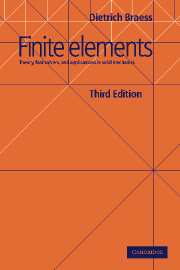Book contents
- Frontmatter
- Contents
- Preface to the Third English Edition
- Preface to the First English Edition
- Preface to the German Edition
- Notation
- Chapter I Introduction
- Chapter II Conforming Finite Elements
- Chapter III Nonconforming and Other Methods
- Chapter IV The Conjugate Gradient Method
- Chapter V Multigrid Methods
- Chapter VI Finite Elements in Solid Mechanics
- References
- Index
Chapter VI - Finite Elements in Solid Mechanics
Published online by Cambridge University Press: 01 March 2010
- Frontmatter
- Contents
- Preface to the Third English Edition
- Preface to the First English Edition
- Preface to the German Edition
- Notation
- Chapter I Introduction
- Chapter II Conforming Finite Elements
- Chapter III Nonconforming and Other Methods
- Chapter IV The Conjugate Gradient Method
- Chapter V Multigrid Methods
- Chapter VI Finite Elements in Solid Mechanics
- References
- Index
Summary
Finite element methods are the most widely used tools for computing the deformations and stresses of elastic and inelastic bodies subject to loads. These types of problems involve systems of differential equations with the following special feature: the equations are invariant under translations and orthogonal transformations since the elastic energy of a body does not change under so-called rigid body motions.
Practical problems in structural mechanics often involve small parameters which can appear in both obvious and more subtle ways. For example, for beams, membranes, plates, and shells, the thickness is very small in comparison with the other dimensions. On the other hand, for a cantilever beam, the part of the boundary on which Dirichlet boundary conditions are prescribed is very small. Finally, many materials allow only very small changes in density. These various cases require different variational formulations of the finite element computations. Using an incorrect formulation leads to so-called locking. Often, mixed formulations provide a suitable framework for both the computation and a rigorous mathematical analysis.
Most of the characteristic properties appear already in the so-called linear theory, i.e., for small deformations where no genuine nonlinear phenomenon occurs. However, strictly speaking, there is no complete linear elasticity theory, since the above-mentioned invariance under rigid body motions cannot be completely modeled in a linear theory. For this reason, we don't restrict ourselves to the linear theory until later.
- Type
- Chapter
- Information
- Finite ElementsTheory, Fast Solvers, and Applications in Solid Mechanics, pp. 278 - 347Publisher: Cambridge University PressPrint publication year: 2007



